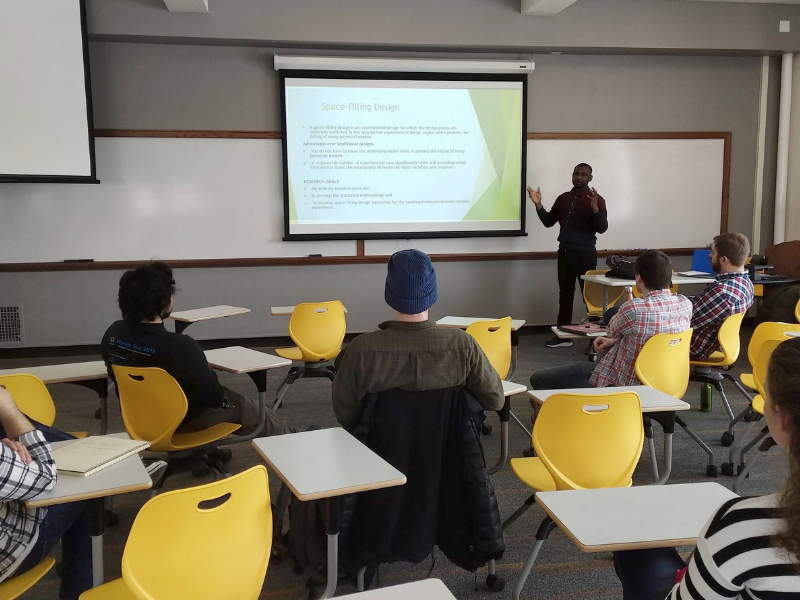DEIA Spotlight - Department of Mathematical Sciences

Department of Mathematical Sciences' DEI Task Force
David Ayala, Katharine Banner, Mary Alice Carlson, Nicole Carnegie, Ryan Grady and Megan Wickstrom
The Task Force on Diversity, Equity and Inclusion (DEI) in the Department of Mathematical Sciences has been reflecting on how our department can contribute to MSU's DEI goals. It is easy to assume that mathematics is an objective endeavor independent of human subjectivity. Still, people do mathematics, and our discipline thrives when we welcome everyone into our community.
A commitment to "advance the status of the profession of mathematics, encouraging and facilitating the full participation of all individuals" is made explicit in the mission statement of the American Mathematical Society,[1] though we recognize that our discipline has not always lived up to that ideal. Myths about what it means to know and do mathematics exist both within and outside the field and act as barriers to the full participation of all individuals.
Many of us have heard the joke, "There are three kinds of people in this world – those who are good at math and those who aren't." While this statement is likely to draw a chuckle, the notion that success in mathematics results from some spark of brilliance rather than sustained hard work pervades Western society and is more than a harmless myth. [2]Disciplines that value or are seen as requiring "brilliance" have the starkest disparities in participation by women and people of color, and mathematics is at the top of that pile. [3]
Members of the DEI task force in the mathematical sciences have been asking ourselves how we value diversity, equity, and inclusion in our discipline and where we need to grow and change. Though our work is ongoing, the answers we are developing are both encouraging and challenging. For one, both mathematics and statistics welcome different ways of approaching problems. This value readily extends to a variety of perspectives and people doing math. Also, mathematical abstraction lends itself to, and is born from, applications. A more diverse community of mathematicians and statisticians broadens the range of priorities represented by those developing and applying methodology, resulting in more innovative approaches responsive to a broader range of societal needsWe also recognize that mathematical and statistical models can disguise biased values and propagate inequity. Indeed, a typical first step in developing a model is deciding which system parameters are the salient ones to measure.
Correspondingly, we see several opportunities through our teaching, mentorship, and curriculum design. One is to diversify imagination of where to find mathematics and how it can be used to identify and address societal issues. Another opportunity is to disseminate a practice of being upfront about applying mathematics to a broader range of contexts and the values and social consequences embedded in them (See Box 1). Another opportunity yet is to align the standard practices in our curriculum with the priorities of communities seeking to embrace mathematical tools.
[Box 1] Here is an example of such an opportunity
|
A Typical Linear Algebra Problem. There are two brands of shoes – brand A and brand B. People buy shoes every six months:
Each pair of shoes not sold is a sunk cost for a given shoe store. Among the 500 pairs of shoes that the store can carry in stock, how many should be brand A and how many should be brand B to maximize profit? Much of this context is not relevant to the mathematical essence of this problem. Meanwhile, the context of this problem sets an imagination that mathematics can be used to maximize profit – a value that we readily accept under the guise of innocuous. In the spirit of shifting imagination to social issues, here is the same problem – through the lens of mathematics – yet premised on a different set of parameters and implied values. |
|
Modified Linear Algebra Problem. There are two rental neighborhoods in Bozeman – the North and the South. Renters renew their leases every six months:
The city of Bozeman injects neighborhood-wide affordable housing incentives based on the concentration of renters. Among the 500 incentives the city has available, how many should be offered to the North and how many to the South to optimize the mission of the incentives? |
We know we have a long way to go. Inequities within the mathematical sciences did not appear overnight. They result from centuries of discriminatory practices, and new wounds are being inflicted on historically underrepresented groups today. We are encouraged by efforts within and across our disciplinary societies (e.g., the American Mathematical Society, the American Statistical Association, and the Association of Mathematics Teacher Educators) and by steps taken to support diversity and inclusion across MSU's campus.
We look forward to creating a more equitable, inclusive, and just discipline that lives up to the ideal of the full participation of all individuals.
[1] http://www.ams.org/about-us/about#:~:text=Mission%20Statement&text=support%20mathematical%20education%20at%20all,other%20disciplines%20and%20everyday%20life.
[2] Anderson, R. K., Boaler,J., & Dieckmann, J. A. (2018). Achieving elusive change through challenging myths about learning: A blended approach. Education Sciences, 8(3), 98-130. doi:10.3390/edusci8020065
[3]Leslie, S. J., Cimpian, A., Meyer, M., & Freeland, E. (2015). Expectations of brilliance underlie gender distributions across academic disciplines. Science, 347(6219), 262-265.
